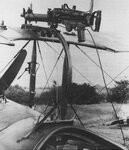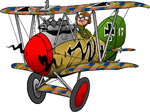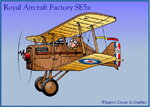Navigation
Install the app
How to install the app on iOS
Follow along with the video below to see how to install our site as a web app on your home screen.
Note: This feature may not be available in some browsers.
More options
You are using an out of date browser. It may not display this or other websites correctly.
You should upgrade or use an alternative browser.
You should upgrade or use an alternative browser.
Whats your favorite aircraft from WWI??
- Thread starter DaveB.inVa
- Start date
Ad: This forum contains affiliate links to products on Amazon and eBay. More information in Terms and rules
More options
Who Replied?SaparotRob
Unter Gemeine Geschwader Murmeltier XIII
The SE 5A. It was the best Allied fighter in the comic book "Enemy Ace" by DC comics.
Thumpalumpacus
Major
This are the ones I like by their nationalities:
Great Britain - S.E.5a
France - Spad XIII
Germany - Albatros DIII
Exactly my preferences as well.
buffnut453
Captain
I have a new favourite...the Bristol F2b Fighter. It jumped to the top of my priority list when I discovered a first cousin of my Grandmother, who lived across the street from her, flew Brisfits with 11 Sqn in WW1.
Here's a pic of one of the airframes recorded in his logbook (not sure how the pilot would reach the gun above the top wing in flight...the mount seems pretty tall to my eyes):

Here's a pic of one of the airframes recorded in his logbook (not sure how the pilot would reach the gun above the top wing in flight...the mount seems pretty tall to my eyes):
Thumpalumpacus
Major
I have a new favourite...the Bristol F2b Fighter. It jumped to the top of my priority list when I discovered a first cousin of my Grandmother, who lived across the street from her, flew Brisfits with 11 Sqn in WW1.
Here's a pic of one of the airframes recorded in his logbook (not sure how the pilot would reach the gun above the top wing in flight...the mount seems pretty tall to my eyes):
I believe the guns were fired via a trigger in the cockpit (you can see the cable on the right side of this pic), and slid down and back along rails in order to reload on the Foster mount:
If you magnify your own photo, you'll see that this Brisfit does have a Foster mount.
I can't remember which British ace it was who'd unlock the gun and bring it partially down the rails (on his SE5a) in order to shoot vertically into the bellies of an opponent. Or maybe that was just him posing, as the pic I've seen was taken on the ground.
Attachments
buffnut453
Captain
I believe the guns were fired via a trigger in the cockpit (you can see the cable on the right side of this pic), and slid down and back along rails in order to reload on the Foster mount:
View attachment 627042
If you magnify your own photo, you'll see that this Brisfit does have a Foster mount.
I can't remember which British ace it was who'd unlock the gun and bring it partially down the rails (on his SE5a) in order to shoot vertically into the bellies of an opponent. Or maybe that was just him posing, as the pic I've seen was taken on the ground.
Agree it's a Foster Mount...but on E2586 it's been fitted on stilts and stands a good foot or more above the upper surface of the wing. Just reaching that in flight would have been....sporting?!
Thumpalumpacus
Major
Agree it's a Foster Mount...but on E2586 it's been fitted on stilts and stands a good foot or more above the upper surface of the wing. Just reaching that in flight would have been....sporting?!
Agreed, reloading would have been tricky, and clearly a straight-and-level evolution. But the actual firing would've been done while sitting and maneuvering.
Though I gotta say that doing a straight-and-level reload in combat is probably not a good idea! Drums held either 47 or 97 rounds, and I'm not sure which drum any of the WWI planes under discussion used. But changing it in flight probably got one's pucker-meter moving the needle clockwise.
Being a gunner in an FE2b would send my the pucker meter off the charts. Here's a shot of the how the gunner would fire to the rear. All he had to hold onto was a gun on a swivel mount; everything above his ankles was hanging out in the breeze. During flight, the gunner would sit on the edge of his cockpit, facing backwards to keep an eye out for enemy aircraft. Those guys were made of pretty stern stuff.

Picture from the Tangmere Museum.
Picture from the Tangmere Museum.
Last edited:
buffnut453
Captain
Being a gunner in an FE2 would send my the pucker meter off the charts. Here's a shot of the how the gunner would fire to the rear. All he had to hold onto was a gun on a swivel mount; everything above his ankles was hanging out in the breeze. During flight, the gunner would sit on the edge of his cockpit, facing backwards to keep an eye out for enemy aircraft. Those guys were made of pretty stern stuff.
View attachment 627056
Picture from the Tangmere Museum.
And pray that the tether strap connecting them to the aircraft didn't snap.
Thumpalumpacus
Major
Being a gunner in an FE2 would send my the pucker meter off the charts. Here's a shot of the how the gunner would fire to the rear. All he had to hold onto was a gun on a swivel mount; everything above his ankles was hanging out in the breeze. During flight, the gunner would sit on the edge of his cockpit, facing backwards to keep an eye out for enemy aircraft. Those guys were made of pretty stern stuff.
View attachment 627056
Picture from the Tangmere Museum.
Now imagine the maneuvering that comes along with the pilot making his a/c a difficult target. Jesus please us!
buffnut453
Captain
This is one of the scariest aircraft I've ever seen...the BE9 which, thank heavens, never went into production (although a single version was actually sent to France for operational trials and flew a few sorties):

The potential problems with this design are many...proximity to the propeller, communicating with the pilot, risk of getting crushed by the engine in a landing....etc.
The potential problems with this design are many...proximity to the propeller, communicating with the pilot, risk of getting crushed by the engine in a landing....etc.
Thumpalumpacus
Major
The great thing about the early days of aviation is seeing what designers were willing to throw at the wall to see what stuck. Many not sensible at all, but the creativity is just off the charts.
Thumpalumpacus
Major
Some real head scratchers here.
Be happy jet propulsion was few decades ahead.
but on E2586 it's been fitted on stilts and stands a good foot or more above the upper surface of the wing.
Interesting photo Mark.
This is amateurish, but a schematic with those accompanying printed scales - shows the gun must be mounted at least 16" above the top wing to miss hitting the tips of the massive 9' 8" prop...
I once read that, throughout WWI, the Camel was credited with bringing down about 450 enemy machines. That same article went on to say that the Camel killed about 435 of it's own pilots in non combat related accidents. I think that 'Deadly' is an apt description. Postscript: I once had occasion to speak with a pilot who built and flew an exact replica of a Sopwith Camel at Old Rhinebeck Aerodrome. I asked him how filling the secondary fuel tank located behind the pilot affected handling. He told me that he never put fuel in that tank and that the Camel was an airplane with so many handling quirks that to safely learn to fly it a pilot had to operate at sufficiently high altitudes to enable recovery from the inevitable mistakes.I like the Sopwith camel - a bitch to fly but once mastered a deadly machine.
wingnuts
Airman 1st Class
Exactly my preferences as well.
Attachments
The Air and Space Museum site credits the Camel with 1294 aircraft shot down, and I think Wiki also credits it with about the same number, but that's Wiki.I once read that, throughout WWI, the Camel was credited with bringing down about 450 enemy machines. That same article went on to say that the Camel killed about 435 of it's own pilots in non combat related accidents. I think that 'Deadly' is an apt description. Postscript: I once had occasion to speak with a pilot who built and flew an exact replica of a Sopwith Camel at Old Rhinebeck Aerodrome. I asked him how filling the secondary fuel tank located behind the pilot affected handling. He told me that he never put fuel in that tank and that the Camel was an airplane with so many handling quirks that to safely learn to fly it a pilot had to operate at sufficiently high altitudes to enable recovery from the inevitable mistakes.
There's even one site that claims the Camel shot down over 3000 !!!
But since the Luftskeitkrafte lost 3126 aircraft due to enemy action during the entire war, I think that 3000 figure is very doubtful.
Even the 1294 looks a little high when you consider that that means the Germans loses due to the Camel were over 1/3 for the entire war, and the Camel was in use only a little over a year and a half.
Last edited:
space dodo
Airman 1st Class
sopwith dolphin
Users who are viewing this thread
Total: 1 (members: 0, guests: 1)



